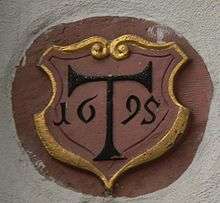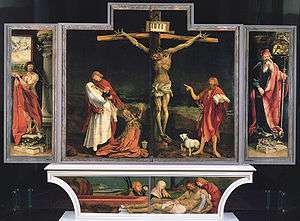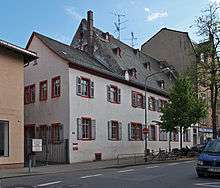Hospital Brothers of St. Anthony

The Hospital Brothers of St. Anthony, Order of St. Anthony or Canons Regular of St. Anthony of Vienne (Canonici Regulares Sancti Antonii, or CRSAnt), also Antonines, were a Roman Catholic congregation founded in c. 1095, with the purpose of caring for those suffering from the common medieval disease of St. Anthony's fire.
History

The congregation was founded c. 1095 by Gaston of Valloire, a nobleman of the Dauphiné, and his son, and confirmed by Pope Urban II in the same year, in thanksgiving for the son's miraculous cure from St. Anthony's fire thanks to the relics of Saint Anthony the Great.
The relics were housed in the church of Saint Anthony at La-Motte-Saint-Didier (the present Saint-Antoine-l'Abbaye, Isère), to which was attached a Benedictine priory, whose members tended the shrine. Gaston and his community, which at this date was composed of laymen, set up a hospital nearby, where they cared for pilgrims to the shrine and for the sick, particularly those afflicted with St. Anthony's fire,[1] a disease very common in the Middle Ages, particularly among the poor. Relations with the resident Benedictines were not good, however, and conflicts were frequent.
The members of the community wore a black habit with the Greek letter Tau (also known as St. Anthony's cross) in blue. At first laymen, they received sanction as a monastic order from Pope Honorius III in 1218. In 1248 they adopted the Rule of St. Augustine and were constituted canons regular by Pope Boniface VIII in 1297. At this time the conflict that had grown up between the Antonines and the Benedictine monks responsible for the relics had become severe: the Pope put an end to it by dismissing the Benedictines to Montmajour Abbey and giving custody of the shrine to the Antonines.
Due to the community's successes further hospitals were opened in Gap, Chambéry and Besançon, and later in Spain, Italy, Flanders and Germany, where one of their first monasteries and hospitals was opened in 1214 in Memmingen.[2] The congregation spread still more during the 14th century, during which they also cared for those suffering from the Black Death, and at its height, in the 15th century, possessed about 370 hospitals. The congregation also produced a number of distinguished scholars and prelates. Among their privileges was that of caring for the sick of the papal household.
Their beneficent activities attracted generous gifts and endowments, but their income declined significantly after the Reformation, and more particularly once the connection was finally made between St. Anthony's Fire and the ergot fungus, and the incidence of the affliction fell sharply. In 1616 a reform was ordained and partially carried out. In 1777 the congregation, hugely reduced,[3] was canonically united with the Knights of Malta. Only a tiny number of houses remained open, and the remnants of the order were finally suppressed in the French Revolution and the years immediately following. The last few German houses were dissolved during the secularisation of 1803.

List of houses
England
See also
| Wikimedia Commons has media related to Hospital Brothers of St. Anthony. |
Notes
- ↑ usually taken to mean ergotism, although it can also refer to erysipelas and other skin diseases
- ↑ now a museum of the Hospital Brothers of St. Anthony and their work: see link below
- ↑ 220 canons in the whole of France
References and sources
- Antonine Museum, Memmingen (German)
- Œuvres Hospitalières Françaises de l'Ordre de Malte (French)
- Catholic Encyclopedia: Orders of St. Anthony
- Sandell-Dupeley, Renée, 1988: Saint Antoine en Dauphiné. ccl éditions (French)